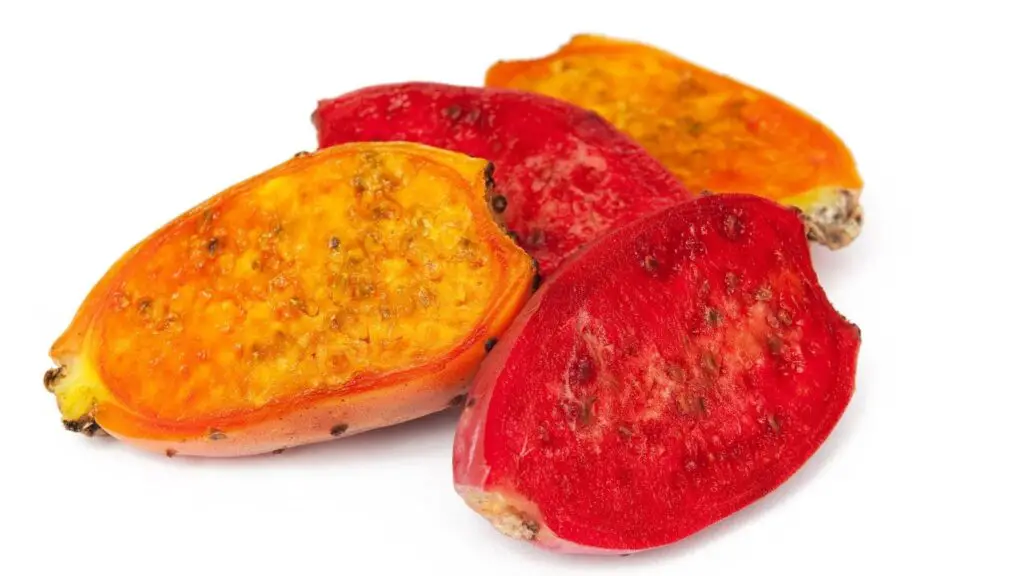Pawscessories is reader-supported. When you buy via links on our site, we may earn an affiliate commission at no cost to you.
Learn more.
Prickly pears are a popular fruit that can be found all over the world. They can be eaten fresh, juiced, or made into a variety of dishes.
The prickly pear is also known as the cactus fruit, and it’s no surprise that this spiky plant is related to the cactus.
Since you’ve made it to this post, you’re probably enjoying a prickly pear and wondering, “can dogs eat prickly pear? Can dogs eat cactus fruit?”
Or perhaps Fiddo got a hold of a prickly pear, and you are concerned.
Considering they are pretty healthy for us humans to eat, you’d probably think it’s okay for dogs to eat prickly pears. Well, you’d actually be incorrect.
Dogs should not eat prickly pears (or cactus fruits)! While they are not considered toxic according to the ASPCA poison control, some veterinarians would disagree. In situations where expert opinions are conflicting, it’s best to avoid feeding it to your dog.
In this article, you’ll discover:
- Why dogs shouldn’t eat prickly pears
- The dangers associated with dogs eating prickly pears
- What to do if your dog eats some prickly pears
Let’s dive in.
Table of Contents

What Is Prickly Pear Cactus?
In order to understand why dogs shouldn’t eat prickly pear cacti, let’s start with the basics.
The prickly pear cactus is a fruit that grows on top of the pads of certain types of cacti in the Opuntia genus. It’s also sometimes called cactus fruit, cactus fig, Indian fig, or barbary fig.
Prickly pear cactus is a popular fruit used in various dishes, including salads, juices, jams, jellies, and even wine. It appears like a large pear or peach with a thick layer of skin. Unfortunately, it also contains spines or glochids, which are tiny barbs that can be difficult to remove.
Can Dogs Eat Prickly Pears? (AKA Cactus Fruit)
Dogs shouldn’t eat prickly pears mainly because of the spines or glochids. These can cause injury to your dog’s mouth, throat, and digestive tract. If ingested, they can also puncture your dog’s intestines leading to a severe infection called peritonitis.
The cactus fruits also contain a fibrous plant material that can easily cause irritation and stomach problems to your dog leading to vomiting and diarrhea. I
Although the ASPCA claims the cactus fruit is not toxic for dogs, some veterinarians would disagree.
While a small amount of cactus fruit is unlikely to harm your dog, excessive consumption can lead to constipation, diarrhea, and vomiting.
Overall, it’s best to avoid feeding your dog this, but there’s no need to panic if your dog gets into some.
If your dog has eaten some, here’s what you can do.
What To Do If Your Dog Eats A Prickly Pear?

Since cactus fruit is considered non-toxic, 99 out of 100 times, a dog will have no issues after consuming some.
However, a concern is the spines (most people call these thorns) that could damage the inside of your dog’s mouth, throat, or digestive system on the way down.
These can cause irritation, inflammation, and even infection.
The good news is that if you notice any of these symptoms, they’re usually not life-threatening and can be fixed with a trip to the vet or some at-home treatment.
But, even so, if you notice anything unusual about your dog’s behavior, it’s always best to play it safe and get professional help.
Here are some things you should look out for after your dog eats a cactus fruit:
- Excessive drooling
- Vomiting
- Diarrhea
- Lethargy
- Constipation
- Blood in stool
- Decreased appetite
If you notice any of these symptoms, it’s best to speak with someone who can identify if your dog is at risk.
At-Home Treatment For A Dog Who Ate A Prickly Pear
If you’re uncomfortable taking your dog to the vet or can’t get there right away, here are a few things you can do at home.
Give them plenty of water. This will help them stay hydrated and also help flush out any spines that may be stuck in their system.
Monitor them closely. Watch for any changes in energy levels, appetite, or bathroom habits.
If they start vomiting or have diarrhea, ensure they’re still drinking water to stay hydrated. Try giving them ice cubes if they are refusing to drink.
You can also give them a small amount of plain white rice to help settle their stomach.
You can also speak directly with a vet for immediate help. Click here to speak with a vet online.
If your dog eats a prickly pear, it’s always best to go to the vet instead then trying to solve things yourself.
How To Make Prickly Pear Cactus Edible For Dogs?
The best way to make prickly pear cactus edible for dogs is to remove the spines or glochids. You can do this by carefully cutting off the skin of the fruit with a sharp knife.
You can also roast the fruit, which will cause the spines to fall off. Once you’ve removed the spines, the fruit can be fed to your dog in small amounts.
Other Frequently Asked Questions
Is Cactus Fruit Poisonous To Dogs?

No, cactus fruit is not poisonous to dogs. According to the ASPCA poison control, cactus fruit is considered non-toxic to dogs.
However, it can cause some gastrointestinal upset if they eat too much of it, so it’s best to avoid feeding it to dogs.
Why Do Dogs Love To Eat Prickly Pear Cactus?
Dogs love to eat prickly pear cactus for the same reason we do – it’s delicious! The sweet taste of the fruit is hard for dogs (and humans) to resist.
It’s also possible that your dog is attracted to the cactus fruit because they’re trying to fulfill a nutritional need.
For example, if your dog lacks vitamin C, they may be attracted to the cactus fruit because it’s a good source of this nutrient. This happens naturally in the wild when animals seek certain foods to meet their nutritional needs.
Do Prickly Pears Cause Constipation In Dogs?
If a dog were to overeat some prickly pear, they might end up with constipation as a result. This is because the fruit contains a lot of fiber, which can lead to digestive issues if consumed in large quantities.
Do Cactus Needles Dissolve in Dogs?
Cactus needles will dissolve in a dog’s stomach acid. However, they must be removed if the needles get stuck in a dog’s skin, mouth, or throat.
If you see cactus needles in your dog, the best thing to do is to use a pair of tweezers to remove them. After removal, use antibiotic ointment on the area to prevent infection.
Other posts you may find interesting:
Can Dogs Eat Ghost Peppers? All You Need To Know
